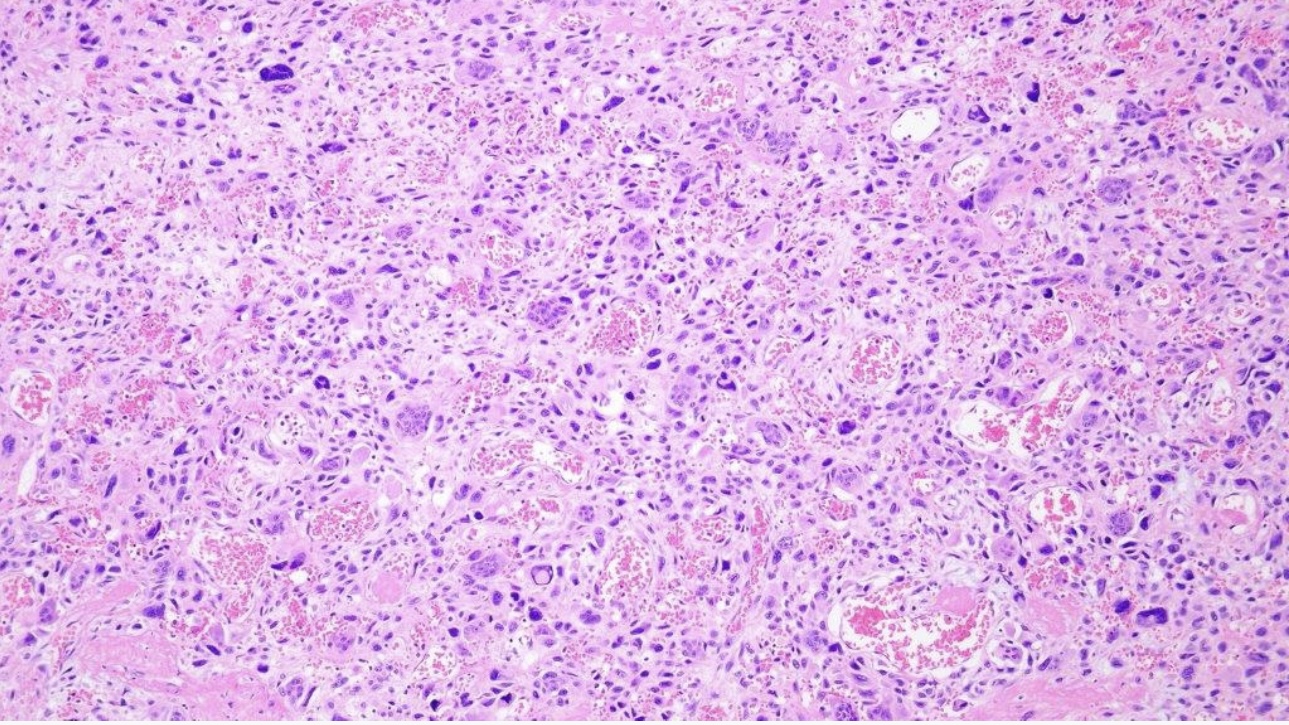Monday Poster Session
Category: Small Intestine
P4098 - The Bleeding Giant: A Rare Case of Duodenal Undifferentiated Carcinoma with Osteoclast-Like Giant Cells Requiring Whipple Resection
Monday, October 27, 2025
10:30 AM - 4:00 PM PDT
Location: Exhibit Hall
- DK
Diksha Kajal, MD
Florida State University
Cape Coral, FL
Presenting Author(s)
Diksha Kajal, MD1, Rahul Kumar, MD2, Marilin Rosa, MD3, Iryna S. Hepburn, MD, FACG1
1Florida State University, Cape Coral, FL; 2North Central Bronx Hospital, Bronx, NY; 3NeoGenomics Laboratories, Fort Myers, FL
Introduction: Sarcomatous malignancies are a broader term that refers to tumors resembling sarcomas (i.e.,
mesenchymal differentiation). Some sarcomatoid malignancies of the duodenum and pancreas exhibit
features consistent with undifferentiated carcinoma with osteoclast-like giant cells (UC-OGC), but are
exceptionally rare and highly aggressive, often presenting with nonspecific symptoms during advanced
disease. There is limited literature available to guide diagnosis and management. We present a rare case
of a duodenal mass with sarcomatoid features, complicated by gastrointestinal bleeding, ultimately
diagnosed as UC-OGC.
Case Description/
Methods: An 81-year-old female with a remote history of bladder cancer, ileal conduit, and hysterectomy
presented with melena, left lower quadrant pain, weakness, and nausea. Labs showed hemoglobin 9.8
g/dL with a BUN/Cr ratio of 45, concerning upper GI bleeding. CT abdomen revealed mucosal thickening
in the proximal duodenum.
EGD demonstrated a large friable, malignant-appearing mass extending from the first to the second
portion of the duodenum, occupying 50–60% of the lumen. Biopsies revealed a high-grade sarcomatous
malignancy composed of poorly differentiated atypical cells. Surgical oncology deemed the tumor
resectable. The patient was discharged but returned with recurrent bleeding and underwent a
pancreaticoduodenectomy (Whipple procedure) with Braun enteroenterostomy. Final pathology
confirmed undifferentiated carcinoma with osteoclast-like giant cells and extensive lymphovascular
invasion, with liver biopsy revealing metastatic disease.
Discussion: This case highlights the diagnostic and therapeutic challenges of rare sarcomatoid and undifferentiated
tumors of the duodenum, including undifferentiated carcinoma with osteoclast-like giant cells (UC-OGC).
UC-OGC shares key driver mutations with pancreatic ductal adenocarcinoma (KRAS, TP53, CDKN2A,
SMAD4) yet displays distinct morphology and rapid clinical progression. These tumors often present late
with bleeding or obstructive symptoms and carry a poor prognosis due to early metastasis and limited
response to systemic therapies. Surgical resection remains the mainstay of treatment in select patients.
UC-OGC should be considered in elderly patients with unexplained upper GI bleeding, and timely
diagnosis requires close coordination between gastroenterology, surgery, pathology, and oncology
teams.

Figure: Microscopic findings showed highly pleomorphic malignant cells, no glandular differentiation, and a prominent infiltration by osteoclast-like giant cells. Extensive lymphovascular invasion (H&E, x 100)

Figure: EGD showing a large mass extending from the first portion of the duodenum to the second part,occupying 50 to 60% of duodenal circumference.
Disclosures:
Diksha Kajal indicated no relevant financial relationships.
Rahul Kumar indicated no relevant financial relationships.
Marilin Rosa indicated no relevant financial relationships.
Iryna Hepburn indicated no relevant financial relationships.
Diksha Kajal, MD1, Rahul Kumar, MD2, Marilin Rosa, MD3, Iryna S. Hepburn, MD, FACG1. P4098 - The Bleeding Giant: A Rare Case of Duodenal Undifferentiated Carcinoma with Osteoclast-Like Giant Cells Requiring Whipple Resection, ACG 2025 Annual Scientific Meeting Abstracts. Phoenix, AZ: American College of Gastroenterology.
1Florida State University, Cape Coral, FL; 2North Central Bronx Hospital, Bronx, NY; 3NeoGenomics Laboratories, Fort Myers, FL
Introduction: Sarcomatous malignancies are a broader term that refers to tumors resembling sarcomas (i.e.,
mesenchymal differentiation). Some sarcomatoid malignancies of the duodenum and pancreas exhibit
features consistent with undifferentiated carcinoma with osteoclast-like giant cells (UC-OGC), but are
exceptionally rare and highly aggressive, often presenting with nonspecific symptoms during advanced
disease. There is limited literature available to guide diagnosis and management. We present a rare case
of a duodenal mass with sarcomatoid features, complicated by gastrointestinal bleeding, ultimately
diagnosed as UC-OGC.
Case Description/
Methods: An 81-year-old female with a remote history of bladder cancer, ileal conduit, and hysterectomy
presented with melena, left lower quadrant pain, weakness, and nausea. Labs showed hemoglobin 9.8
g/dL with a BUN/Cr ratio of 45, concerning upper GI bleeding. CT abdomen revealed mucosal thickening
in the proximal duodenum.
EGD demonstrated a large friable, malignant-appearing mass extending from the first to the second
portion of the duodenum, occupying 50–60% of the lumen. Biopsies revealed a high-grade sarcomatous
malignancy composed of poorly differentiated atypical cells. Surgical oncology deemed the tumor
resectable. The patient was discharged but returned with recurrent bleeding and underwent a
pancreaticoduodenectomy (Whipple procedure) with Braun enteroenterostomy. Final pathology
confirmed undifferentiated carcinoma with osteoclast-like giant cells and extensive lymphovascular
invasion, with liver biopsy revealing metastatic disease.
Discussion: This case highlights the diagnostic and therapeutic challenges of rare sarcomatoid and undifferentiated
tumors of the duodenum, including undifferentiated carcinoma with osteoclast-like giant cells (UC-OGC).
UC-OGC shares key driver mutations with pancreatic ductal adenocarcinoma (KRAS, TP53, CDKN2A,
SMAD4) yet displays distinct morphology and rapid clinical progression. These tumors often present late
with bleeding or obstructive symptoms and carry a poor prognosis due to early metastasis and limited
response to systemic therapies. Surgical resection remains the mainstay of treatment in select patients.
UC-OGC should be considered in elderly patients with unexplained upper GI bleeding, and timely
diagnosis requires close coordination between gastroenterology, surgery, pathology, and oncology
teams.

Figure: Microscopic findings showed highly pleomorphic malignant cells, no glandular differentiation, and a prominent infiltration by osteoclast-like giant cells. Extensive lymphovascular invasion (H&E, x 100)

Figure: EGD showing a large mass extending from the first portion of the duodenum to the second part,occupying 50 to 60% of duodenal circumference.
Disclosures:
Diksha Kajal indicated no relevant financial relationships.
Rahul Kumar indicated no relevant financial relationships.
Marilin Rosa indicated no relevant financial relationships.
Iryna Hepburn indicated no relevant financial relationships.
Diksha Kajal, MD1, Rahul Kumar, MD2, Marilin Rosa, MD3, Iryna S. Hepburn, MD, FACG1. P4098 - The Bleeding Giant: A Rare Case of Duodenal Undifferentiated Carcinoma with Osteoclast-Like Giant Cells Requiring Whipple Resection, ACG 2025 Annual Scientific Meeting Abstracts. Phoenix, AZ: American College of Gastroenterology.
